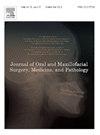多节段Le Fortⅰ型截骨联合矢状分叉支截骨对牙面畸形患者上颌骨稳定性的影响
IF 0.4
Q4 DENTISTRY, ORAL SURGERY & MEDICINE
Journal of Oral and Maxillofacial Surgery Medicine and Pathology
Pub Date : 2024-12-27
DOI:10.1016/j.ajoms.2024.12.015
引用次数: 0
摘要
目的应用正位和侧位头颅造影评价多节段Le Fortⅰ型截骨联合矢状裂支截骨治疗牙面畸形患者的骨稳定性。方法选取2011年1月至2021年12月在我院行Le Fort I型多节段截骨术的牙面畸形患者19例(男3例,女16例)。手术时患者平均年龄为27岁(年龄范围:15-46岁)。根据侧位头颅测量测定ANB角度,将患者分为骨骼II类和III类:4)、III类(ANB角<;1).通过术前即刻(T0)、术后数日(T1)、术后1年(T2)摄额位、侧位头颅片分析上颌、下颌骨位置的变化。结果手术中上颌和下颌骨的活动量各不相同。另一方面,大多数受试者的上下颌骨术后变化量约为1 mm,说明多节段Le Fort I型截骨术后骨骼稳定性较高。结论MSL1术后上颌位置总体稳定,但对于开咬、不对称和/或上颌牙弓增大的患者,应谨慎控制术后复发。本文章由计算机程序翻译,如有差异,请以英文原文为准。
Stability of the maxilla and mandible in patients with dentofacial deformities after multi-segmental Le Fort I osteotomy combined with sagittal split ramus osteotomy
Objective
Skeletal stability after multi-segmental Le Fort I osteotomy combined with sagittal split ramus osteotomy in patients with dentofacial deformities was evaluated using frontal and lateral cephalograms in this study.
Methods
The subjects were 19 patients (3 males and 16 females) with dentofacial deformities who had undergone multi-segmental Le Fort I osteotomy at our hospital between January 2011 and December 2021. The mean age of the patients at the time of surgery was 27 years (age range: 15–46 years). The patients were classified into skeletal Class II and Class III groups according to the ANB angle determined by lateral cephalometric analysis: Class II (ANB angle> 4), and Class III (ANB angle < 1). Changes in the positions of the maxilla and mandible were analyzed with frontal and lateral cephalograms taken immediately before surgery (T0), a few days after surgery (T1), and one year after surgery (T2).
Results
The amount of movement of the maxilla and mandible at surgery varied from case to case. On the other hand, the amount of postoperative change in the maxilla and mandible was about 1 mm in most subjects, suggesting that skeletal stability after multi-segmental Le Fort I osteotomy is quite high.
Conclusions
Postoperative maxillary position after MSL1 was stable overall, but postoperative relapse should be carefully controlled in cases with open bite, asymmetry, and/or enlarged maxillary dental arch.
求助全文
通过发布文献求助,成功后即可免费获取论文全文。
去求助
来源期刊

Journal of Oral and Maxillofacial Surgery Medicine and Pathology
DENTISTRY, ORAL SURGERY & MEDICINE-
CiteScore
0.80
自引率
0.00%
发文量
129
审稿时长
83 days
 求助内容:
求助内容: 应助结果提醒方式:
应助结果提醒方式:


